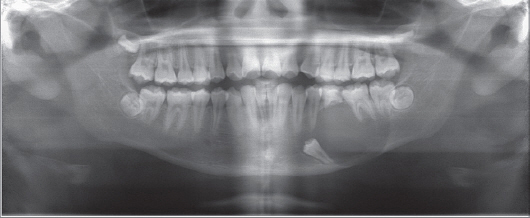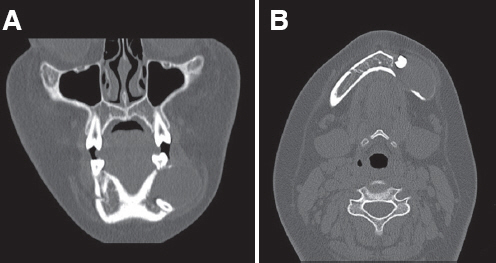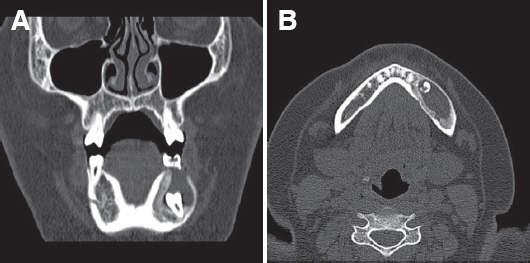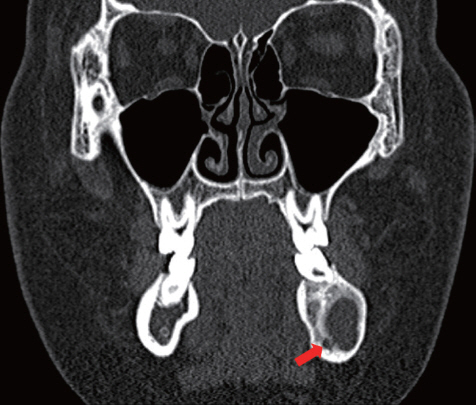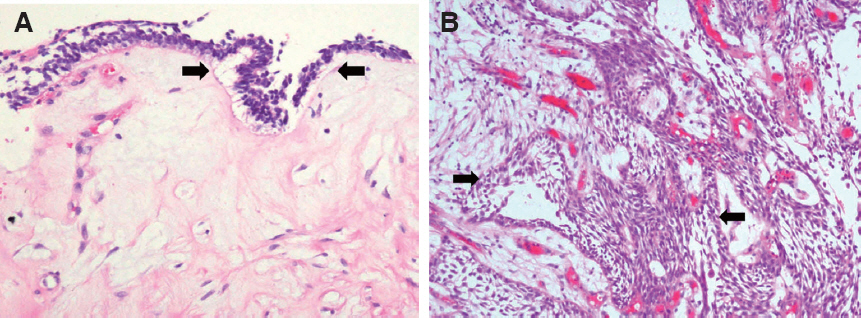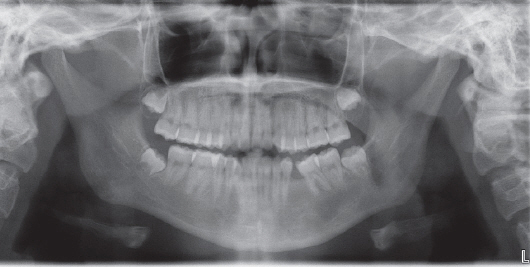J Dent Rehabil Appl Sci.
2018 Sep;34(3):246-250. 10.14368/jdras.2018.34.3.246.
Conservative therapy of extensive unicystic ameloblastoma: a case report
- Affiliations
-
- 1Department of Pathology, Jeju National University Hospital, Jeju National University College of Medicine and Graduate School of Medicine, Jeju, Republic of Korea.
- 2Department of Oral and Maxillofacial Surgery, School of Medicine, Jeju National University, Jeju, Republic of Korea. 2460song@naver.com
- KMID: 2422644
- DOI: http://doi.org/10.14368/jdras.2018.34.3.246
Abstract
- Ameloblastoma is a benign neoplasm originating from odontogenic epithelium. It is the most common neoplasm in the jaws and is characterized by aggressive behavior and local invasion. Unicystic ameloblastoma (UA) has a unilocular feature in radiologic examination and a cystic feature histologically. Decompression and marsupialization are conservative method of treatment of large UA. The purpose of decompression and marsupialization are size reduction of the mass, which makes it easy to handle at total enucleation with protection of nerve damage and facial deformity. Here we report successful conservative treatment of extensive UA using decompression and marsupialization with a review of literatures.
Figure
Reference
-
References
1. de Paulo LF, Oliveira MT, Rodrigues ÁR, Zanetta-Barbosa D. Treatment of an extensive unicystic ameloblastoma in a 7-year-old child:the best approach? Br J Oral Maxillofac Surg. 2015; 53:292–4. DOI: 10.1016/j.bjoms.2014.11.020. PMID: 25542283.2. Dolanmaz D, Etoz OA, Pampu A, Kalayci A, Gunhan O. Marsupialization of unicystic ameloblastoma:a conservative approach for aggressive odontogenic tumors. Indian J Dent Res. 2011; 22:709–12. DOI: 10.4103/0970-9290.93461. PMID: 22406718.3. Robinson L, Martinez MG. Unicystic ameloblastoma:a prognostically distinct entity. Cancer. 1977; 40:2278–85. PMID: 922668. DOI: 10.1002/1097-0142(197711)40:5<2278::AID-CNCR2820400539=3.0.CO;2-L.4. Sano K, Yoshimura H, Tobita T, Kimura S, Imamura Y. Spontaneous eruption of involved second molar in unicystic ameloblastoma of the mandible after marsupialization followed by enucleation:a case report. J Oral Maxillofac Surg. 2013; 71:66–71. DOI: 10.1016/j.joms.2012.04.014. PMID: 22722006.5. Souza Andrade ES, da Costa Miguel MC, Pinto LP, de Souza LB. Ameloblastoma and adenomatoid odontogenic tumor:the role of alpha2beta1, alpha-3beta1, and alpha5beta1 integrins in local invasiveness and architectural characteristics. Ann Diagn Pathol. 2007; 11:199–205. DOI: 10.1016/j.anndiagpath.2006.04.005. PMID: 17498594.6. Sampson DE, Pogrel MA. Management of mandibular ameloblastoma:the clinical basis for a treatment algorithm. J Oral Maxillofac Surg. 1999; 57:1074–7. DOI: 10.1016/S0278-2391(99)90328-2. PMID: 10484108.7. Lau SL, Samman N. Recurrence related to treatment modalities of unicystic ameloblastoma:a systematic review. Int J Oral Maxillofac Surg. 2006; 35:681–90. DOI: 10.1016/j.ijom.2006.02.016. PMID: 16782308.8. Pogrel MA. Decompression and marsupialization as a treatment for the odontogenic keratocyst. Oral Maxillofac Surg Clin North Am. 2003; 15:415–27. DOI: 10.1016/S1042-3699(03)00038-4. PMID: 18088693.9. Kessler HP. Intraosseous ameloblastoma. Oral Maxillofac Surg Clin North Am. 2004; 16:309–22. DOI: 10.1016/j.coms.2004.03.001. PMID: 18088733.10. Seintou A, Martinelli-Kläy CP, Lombardi T. Unicystic ameloblastoma in children:systematic review of clinicopathological features and treatment outcomes. Int J Oral Maxillofac Surg. 2014; 43:405–12. DOI: 10.1016/j.ijom.2014.01.003. PMID: 24503101.11. De Melo WM, Pereira-Santos D, Sonoda CK, Pereira-Freitas SA, de Moura WL, de Paulo Cravinhos JC. Large unicystic ameloblastoma of the mandible:management guided by biological behavior. J Craniofac Surg. 2012; 23:e499–502. DOI: 10.1097/SCS.0b013e3182646b6a. PMID: 22976721.12. Furuki Y, Fujita M, Mitsugi M, Tanimoto K, Yoshiga K, Wada T. A radiographic study of recurrent unicystic ameloblastoma following marsupialization. Report of three cases. Dentomaxillofac Radiol. 1997; 26:214–8. DOI: 10.1038/sj.dmfr.4600250. PMID: 9442611.13. Tomita Y, Kuroda S, Takahashi T, Ohura R, Tanaka E. Orthodontic occlusal reconstruction after conservative treatment of unicystic ameloblastoma in an adolescent patient:10-year follow-up. Am J Orthod Dentofacial Orthop. 2013; 144:466–70. DOI: 10.1016/j.ajodo.2012.06.021. PMID: 23992819.
- Full Text Links
- Actions
-
Cited
- CITED
-
- Close
- Share
- Similar articles
-
- Literature review & case report : the conservative treatment of unicystic ameloblastoma
- Recurrence of maxillary unicystic ameloblastoma: a case report
- A radiologic study of ameloblastoma using computed tomography
- Conservative management (marsupialization) of unicystic ameloblastoma: literature review and a case report
- Unicystic ameloblastoma arising from dentigerous cyst: case report and literature review

